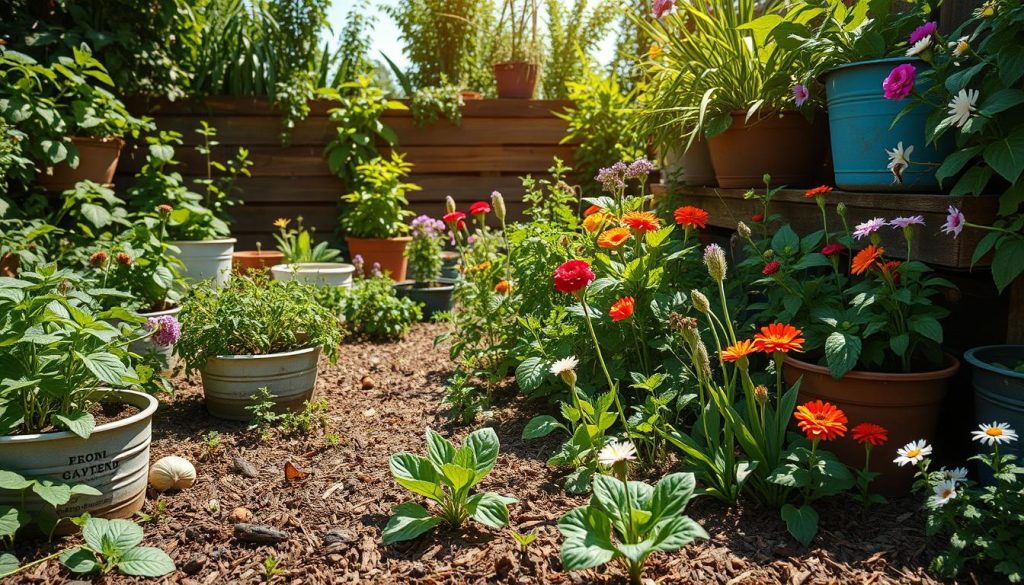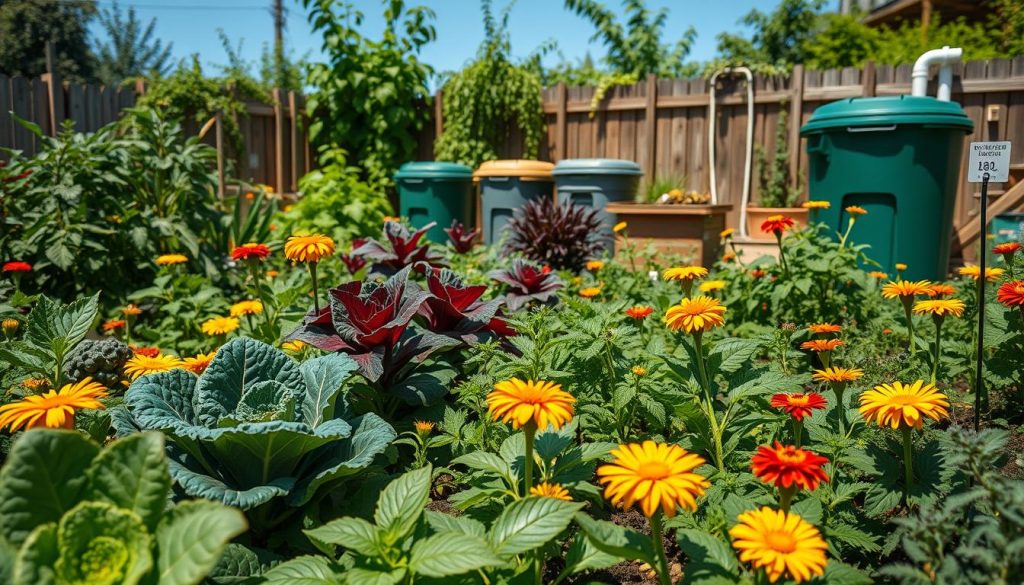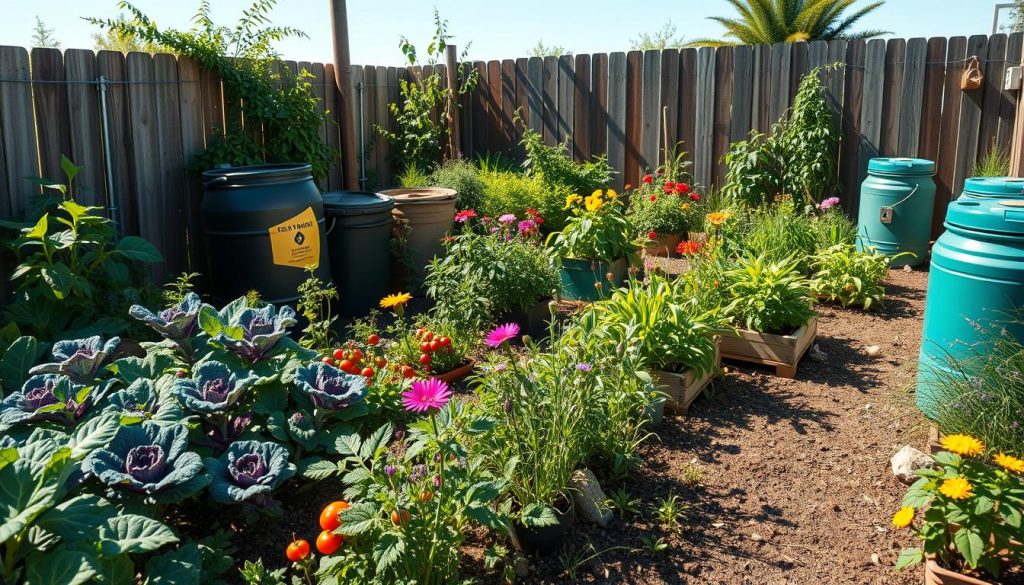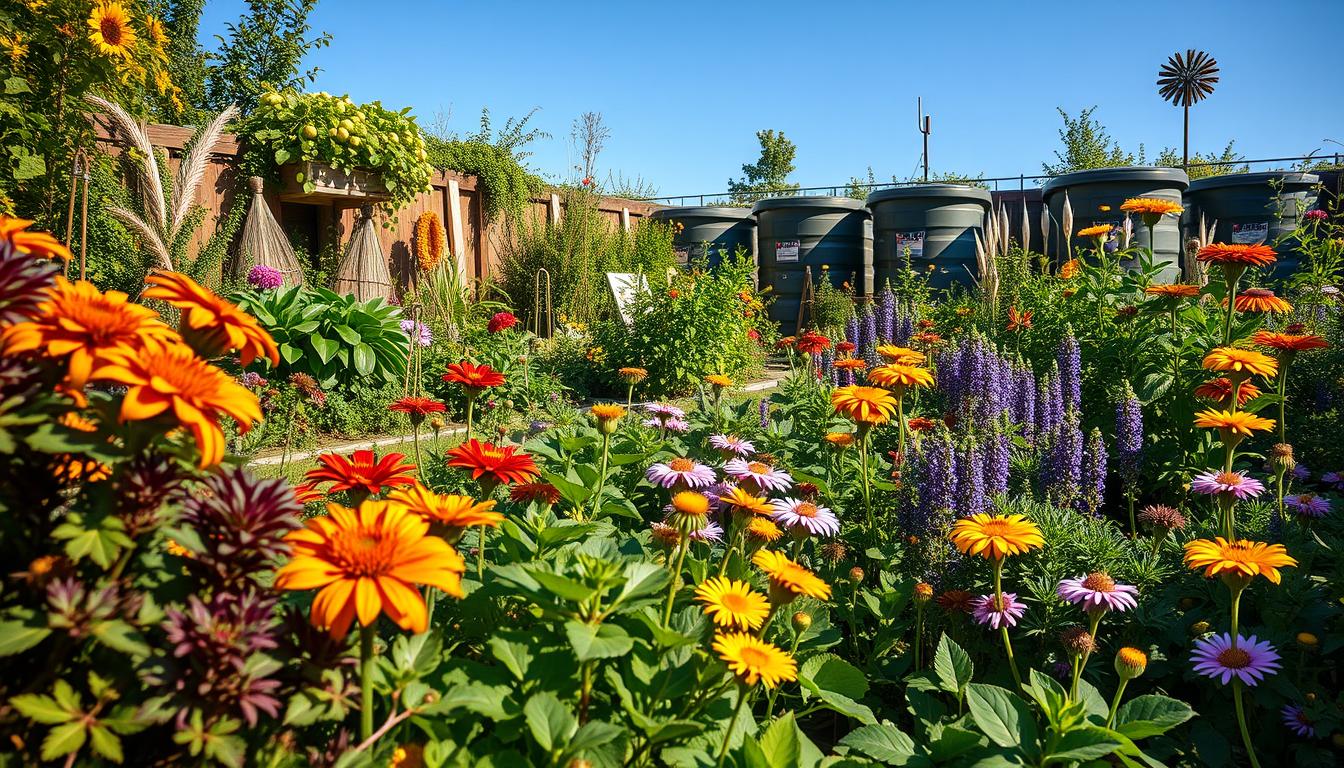I’m excited to share my journey of creating a zero-waste garden. It’s filled with the best plants for living without waste. As I learn about the environment, I want to reduce my waste. Growing my own garden is a great way to do this.
Choosing the right plants is key. I look for eco-friendly indoor and outdoor options. This way, my garden will be beautiful and good for the planet.
In this article, I’ll talk about the best plants for a zero-waste garden. We’ll cover herbs, vegetables, fruits, and more. These plants help reduce waste and promote sustainable living.
Introduction to Zero-Waste Living
Starting a zero-waste lifestyle means making smart choices about what we buy and use. Growing our own plants is a key step. It lets us control the products we use and the waste we make. Zero-waste gardening helps us avoid single-use plastics and cut down on packaging waste.
It’s more than just growing plants. It’s about building a sustainable ecosystem. This way, we can lower our carbon footprint, save water, and support biodiversity. Simple changes in our daily lives can make a big difference for our planet’s future.

- Reduced waste: By growing our own plants, we can reduce our reliance on single-use plastics and packaging materials.
- Conserved water: Zero-waste gardening practices promote water conservation, which is essential for maintaining a healthy and sustainable ecosystem.
- Promoted biodiversity: By creating a sustainable ecosystem, we can promote biodiversity and support local wildlife.
What is Zero-Waste Living?
Zero-waste living is all about cutting down waste to almost nothing. It’s about choosing wisely what we buy, use, and throw away. By living zero-waste, we can lower our carbon footprint, save natural resources, and support sustainability.
Why Grow Your Own Plants?
Growing our own plants is a fantastic way to begin a zero-waste journey. It helps us avoid single-use plastics and packaging waste. Plus, it supports sustainable food systems. Growing plants also encourages us to care for them in an eco-friendly way, which is vital for a healthy ecosystem.
Choosing the Right Plants for My Garden
When picking plants for my zero-waste garden, I focus on organic options. This choice cuts down on waste and helps the local ecosystem. I must think about the climate, soil, and sunlight my garden gets.
Green living plants are perfect for my garden. They fit well with the local environment and need little care. By choosing native plants, I make my garden beautiful and eco-friendly. Important things to consider include:
- Climate and hardiness zone
- Soil type and pH level
- Amount of sunlight and shade
- Water requirements and drought tolerance
For a zero-waste garden, pick plants that need less water. This cuts down on irrigation and waste. By choosing wisely, I create a green space that supports wildlife and reduces my impact on the environment.
Top Edible Plants for Zero-Waste Living
Growing my own edible plants is a key step in reducing waste. I enjoy fresh produce and cut down on single-use plastics. I choose plants that are easy to grow and need little care.
Herbs like basil, mint, and cilantro are great for indoor or outdoor gardens. They add flavor to meals without waste. Tomatoes, cucumbers, and carrots are also favorites. They grow quickly and can be ready in 60 days.
Herbs
- Basil: a popular herb used in many Italian and Thai dishes
- Mint: a hardy herb that can be used in teas, cocktails, and desserts
- Cilantro: a fast-growing herb used in Mexican and Asian cuisine
Veatoes and Fruits
I also grow a variety of vegetables and fruits for my zero-waste garden. Strawberries, blueberries, and raspberries are favorites. They’re delicious and cut down on packaging waste.

Fruits
Fruits like strawberries, blueberries, and raspberries are perfect for a zero-waste garden. They’re easy to grow and add fresh flavor without waste.
Beautiful Plants That Minimize Waste
Exploring zero-waste gardening has shown me more than just growing food. Many beautiful plants can make our garden more eco-friendly. By following zero-waste plant care tips, we can lessen our environmental impact and create a beautiful outdoor space.
Perennials like coneflowers, black-eyed susans, and daylilies are great for a zero-waste garden. They come back every year, needing less care. Succulents and cacti are also excellent, as they need less water and care. Choosing these plants helps us reduce waste and create a lush garden.
Here are some other beautiful plants that can help minimize waste in our garden:
- Marigolds, which can help repel pests and attract beneficial insects
- Nasturtiums, which can add a pop of color and attract beneficial insects
- Calendula, which can help repel pests and attract beneficial insects

By adding these plants to our garden, we can make a stunning and thriving space. It not only reduces waste but also supports beneficial insects and animals. With creativity and the right plants, our garden can become a beautiful, eco-friendly oasis for years.
DIY Projects for a Zero-Waste Garden
I’ve found joy in making my own DIY projects for my garden. Composting with kitchen scraps is a great way to reduce waste. It turns into nutrient-rich soil that helps my plants grow well. This method cuts down on landfill waste and gives my plants a natural fertilizer.
Creating a rain garden is another fun project. It helps me save rainwater, cutting down on my water bill. This eco-friendly idea also makes my garden more sustainable for me and the planet.
- Building a compost bin using recycled materials
- Creating a rainwater harvesting system
- Designing a garden layout that incorporates native plants and minimizes waste
These DIY projects help me make a stunning, eco-friendly garden. They show my dedication to green living and reducing waste. By gardening myself, I lower my environmental impact and enjoy the perks of sustainable living.
Tips for Maintaining a Zero-Waste Garden
Keeping a zero-waste garden alive is a journey worth it. Simple steps can help you save water, handle pests better, and get more from your plants.
Water Conservation Techniques
Using drip irrigation and mulching can cut down on water use. Drip systems send water straight to the roots, saving water. Mulch keeps soil moist. These changes can greatly reduce your garden’s water use.
Sustainable Pest Management
Instead of harsh chemicals, try sustainable plant options for pest control. Planting certain plants together can keep pests away. Also, rotating your crops can stop pests from coming back.
Harvesting for Maximum Yield
Harvesting at the right time is key to avoiding waste and getting the most from your best plants for zero-waste living. Watch when your plants are at their best. This way, you get the most from your garden and waste less.
With these easy tips, you can keep a zero-waste garden thriving. It will help local ecosystems and lessen your environmental footprint.

